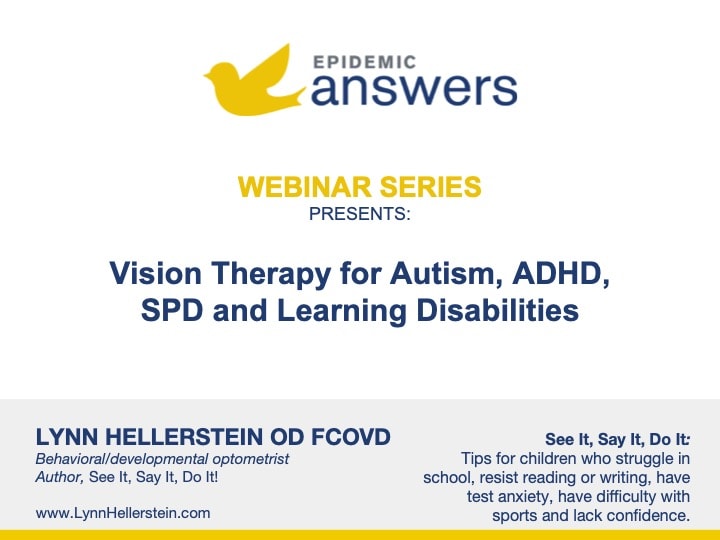In this blog post, Patricia Lemer MEd LPC explains what learning-related vision problems are and how to correct them.
An estimated 25% of school-age children have learning-related vision problems. Students can have difficulties in any of a number of areas. Maybe their two eyes don’t work together to track or focus. These and other problems can have a profound effect on how they learn.
What Are Learning-Related Vision Problems?
Symptoms of vision problems include:
- Eyes that are red or tear when stressed
- Poor hand-eye coordination
- Avoidance of academics
- Decreased comprehension
- Slow reading/writing
- Losing place
- Omitting words
- Skipping lines
- Confusion of similar words
- Discomfort
- Fatigue
- Headaches
- Short attention span when doing schoolwork
Vision Problems and/or Disabilities?
Because vision and learning are intimately connected, vision problems can be easily mistaken for learning or attention problems. Undetected and untreated vision problems can elicit some of the very same signs and symptoms commonly attributed to:
- Impulsivity
- Hyperactivity
- Distractibility
- Poor reading
- Trouble learning math
- Illegible handwriting
In some instances these conditions co-exist and treating one aspect of the problem masks the other.
Eyesight vs. Vision
Eyesight tells only how clear the image is. Vision is more than clarity. It is the brain’s ability to visualize, understand and apply the information that comes in through the eyes: the learned ability to give meaning to what is seen.
From birth, vision works together with the other senses to lay the foundation for cognition, behavior, personality and learning.
Convergence Insufficiency
David Granet, MD and researchers at the Children’s Eye Center, University of San Diego, uncovered a relationship between a common eye-teaming problem called convergence insufficiency and ADHD. In convergence insufficiency, the eyes tend to drift outward when a person is reading or doing close work. When eyes drift out, a person may have double vision.
To prevent seeing double, an individual attempts to make the eyes turn back in or converge, which then interferes with the ability to read and work comfortably at near distances. In the above study, children with convergence insufficiency were three times as likely to be diagnosed with ADHD as children without the disorder.
Does convergence insufficiency make ADHD worse, or is convergence insufficiency misdiagnosed as ADHD? In either case, patients diagnosed with ADHD should be evaluated for convergence insufficiency and treated accordingly.
Visual Function and Autism
Most individuals diagnosed with autism use visual information inefficiently. They frequently have difficulty maintaining visual attention, have eye movement disorders and have eye-teaming problems.
Some of the hallmark behaviors of autism are signs of vision problems:
- Poor eye contact
- Staring at spinning objects or lights
- Side viewing
- Difficulty paying attention
Individuals with autism also often have problems coordinating their central and peripheral vision, ignoring peripheral vision, and fixating on a central point of focus for excessive periods of time.
Poor integration of central and peripheral vision can lead to difficulties in processing and integrating visual information. Motor, cognitive, speech, and perceptual abilities can also be affected when visual processing is interrupted.
A Comprehensive Vision Exam
When children are struggling, a thorough exam including the following is imperative:
- A complete developmental and health history
- A measurement of how clearly the patient can see at a distance and up close: nearsightedness, farsightedness, or astigmatism
- An assessment of eye focusing, eye teaming, and eye movement abilities (accommodation, binocular vision, ocular motility)
- An examination of the health of the eyes
Methods for evaluating the vision of non-verbal individuals vary depending upon levels of emotional and physical development. Many developmental optometrists are experienced in examining people with autism, learning disabilities and other developmental delays.
Patients are sometimes asked to perform specific activities while wearing special lenses. The doctor observes any postural adaptations and compensations the patient makes when sitting, walking, standing, or catching and throwing a ball.
Such tests help to determine how well a patient is using vision, and what can be done to improve performance. Following complete testing, the doctor reviews all findings with the patient and/or parent and provides consultation and recommendations regarding any needed treatment.
Treatment of Learning-Related Vision Problems
Depending on the results of testing, a developmental/behavioral optometrist may prescribe glasses to help the patient compensate for nearsightedness, farsightedness, astigmatism or other problems. He/she might also recommend a program of vision therapy to:
- Increase visual arousal
- Organize visual space
- Improve eye movements
- Gain more efficient eye coordination
- Enhance other important visual abilities
Individualized goals are directed toward resolving underlying visual problems that interfere with reading, learning, and behavior, as vision therapy is not an independent treatment for learning disabilities, attention deficit disorder or autism.
About Patricia S. Lemer LPC MEd
Patricia S. Lemer is a licensed professional counselor, holding a Masters of Education in counseling and learning disabilities from Boston College and a Masters in Business from Johns Hopkins University. She practiced as an educational diagnostician for over 40 years.
She was a co-founder and served as Executive Director of the international non-profit organization Developmental Delay Resources (DDR). After DDR merged with Epidemic Answers, she became Chairman of the Board. When she retired from the board, she became an emeritus board member.

She is the author of three books, the most recent of which is Outsmarting Autism, Updated and Expanded: Build Healthy Foundations for Communication, Socialization, and Behavior at All Ages (North Atlantic Books, 2019).
Lemer wrote over 50 editorials for "New Developments," the quarterly newsletter of Developmental Delay Resources (DDR), from 1995 - 2009. When DDR wound down, she wrote an online blog, "After the Diagnosis, Then What?" from 2009-2017. Her articles and blogs have been updated and archived on the Epidemic Answers website.
Since 2019, Patricia Lemer has recorded a bimonthly podcast, "The Autism Detective." In these hour-long shows, she interviews parents and professionals about their experiences in maximizing the potential of individuals on the autism spectrum. Over 100 episodes are available on Spotify and other online platforms. To learn more, go to PatriciaLemer.com and OutsmartingAutism.com
Still Looking for Answers?
Visit the Epidemic Answers Practitioner Directory to find a practitioner near you.
Join us inside our online membership community for parents, Healing Together, where you’ll find even more healing resources, expert guidance, and a community to support you every step of your child’s healing journey.
Resources
Books
Lemer, Patricia S. Envisioning a Bright Future: Interventions That Work for Children and Adults with Autism Spectrum Disorders. Optometric Extension Program Foundation, 2008.




